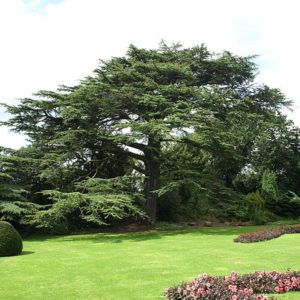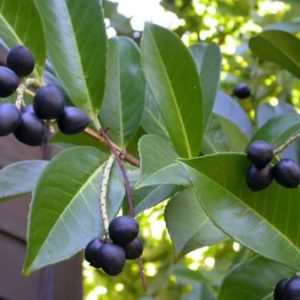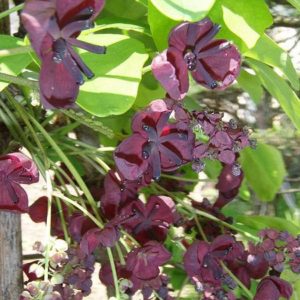-

Callery/ Bradford Pear Seed
Pyrus calleryana£5.00 inc. VATThe Callery Pear is a pretty and resilient ornamental deciduous tree that grows to 15m. When young it has a teardrop shape but spreads with age. The showy white blossom appears before the leaves in spring and gives rise to small hard brown fruits in the Autumn. Good for early bees. Extremely resistant to fire-blight disease.
-

Carolina Silverbell Seed
Halesia carolina£5.00 inc. VATCarolina Silverbell is an elegant, fast growing, deciduous, woodland tree. The delicate, white pendulous bell flowers in emerge with the leaves in spring and are lightly scented. Prized by beekeepers for being a good supply of honey/pollen/nectar. The flowers are followed by four-winged pale green fruit and yellow autumn colour later in the year.
-

Caucasian Wing Nut Seed
Pterocarya fraxinifolia£5.00 inc. VATCaucasian Wing Nut is a large wide spreading deciduous tree with a short trunk and deeply furrowed bark. The leaves are pinnate and up to 60cm long with toothed leaflets. The decorative, pendulous catkins that appear in summer and last into the autumn, are lime green and up to 50cm long. It does better in moist loamy soil and seems to thrive as far north as the Lake District, Cumbria, where it rains a lot, but also gets a fair amount of snow in the winter.
-

Cedar of Lebanon Seed
Cedrus libani£6.00 – £10.00 inc. VATLebanese Cedar is a huge wide-spreading, flat topped conifer, whose characteristic architectural growth habit forms a tiered arrangement. Young trees are conical but branches spread as the tree matures. Cedar of Lebanon has many historical associations. It is the national emblem of Lebanon, and on the Lebanese flag, although there are decreasing numbers growing in the wild. King Solomon is said to have used Cedar timber to build his temple. Cones are large and oval, taking 18 months to mature and then fall to pieces. The timber is prized for furniture making, being close-grained, a good colour and aromatic. Cedar oil extract is used in cosmetics.
Not for forestry purposes.
-

Cherry Laurel / Common Laurel Seed
Prunus laurocerasus£5.00 – £10.00 inc. VATCherry Laurel is vigorous wide spreading evergreen shrub with dark shiny green leaves, often used for screening. It produces attractive erect clusters of white flowers in spring that give rise to small cherry like fruits that eventually turn black. Insects visit the flowers and birds eventually eat the berries. Clip in the summer, for hedging, and the best finish is by using secateurs!
-

Cherry Plum Seed
Prunus myrobalan / cerasifera£5.00 inc. VATCherry Plum is a small, native, deciduous tree smothered in small white flowers in early spring. Mature specimens bear red cherry-plums in late summer and autumn. It is an excellent shrub for a dense hedge and attracts early insects so is useful on meadow edges and mixed plantings of native trees. Tolerant of pruning. Also known as Myrobalan Cherry. (There are other trees from Asia, also know as Myrobalan)
-

Chinese Barberry Seed
Berberis julianae£5.00 – £10.00 inc. VATChinese Barberry is a excellent densely growing, evergreen, spiny-leaved bush. The leaves are copper tinted when young. The scented yellow flowers are borne in bunches of up to 15. It makes a good hedging plant and security barrier.
-

Chinese Flowering Dogwood Seed
Cornus kousa chinensis£5.50 inc. VATChinese Flowering Dogwood is a decorative, slow growing, large shrub or small tree suitable for small gardens. Long-lasting leaf-size pinkish-white bracts surround the small flowers from early summer. Superb autumn colour.
-

Chinese Mahogany Seed
Toona sinensis£5.00 inc. VATToona sinensis is a highly decorative deciduous tree, often multistemmed. The long and large pinnate aromatic leaves are often pink when young and are used in Chinese cuisine. The smooth bark on young trees becomes shaggier with age. Small scented flowers in July, white or pink, are produced in long pannicles at branch ends. The wood is used for furniture as a ‘genuine’ mahogany substitute and also burns aromatically. It is now being investigated as an alternative woodland tree because of climate change and disease issues.
-

Chinese Privet Seed
Ligustrum Sinense£3.00 inc. VATLigustrum Sinense
A vigorous deciduous shrub, up to 4/5m high, with a spreading, arching habit, downy stems and lance-shaped green leaves.Ligustrum sinense is the most free-flowering deciduous privet, forming a large, spreading, arching shrub packed with panicles of white flowers , followed by small, round, black fruit. Tough, it makes an effective boundary hedge and can be easily pruned.
-

Chinese Wisteria Seed
Wisteria sinensis£10.00 – £20.00 inc. VATWisteria is probably the most noble of climbers. The leaves are made up of 9 to 13 oblong leaflets. The highly scented mauve or deep lilac flowers are borne before the leaves in spring and are produced on racemes up to 30cm long. These are followed by velvety seed pods. A mature specimen is a wonder to see and smell. Prune twice a year, shortening the long tendrils in February and again in June.
-

Chocolate Vine Seed
Akebia quinata£5.00 inc. VATThe Chocolate Vine is a vigorous climber, which can be semi evergreen when planted in a sheltered spot. Interesting three ‘petalled’ purple flowers in early summer, with chocolate fragrance. Attractive fresh green leaves made up of five leaflets.
-

Cider Gum Seed
Eucalyptus gunnii£6.60 – £42.00 inc. VATEucalyptus or Cider Gum the best known and hardiest Eucalyptus in cultivation. Its evergreen juvenile leaves are rounded and an outstanding silver blue, much used in floristry. As they mature the leaves become sickle shaped. It can be allowed to develop into a specimen tree, pruned to bush size or coppiced. After pruning, the foliage will grow as juvenile again. Very fast growing. Unlike many Eucalypts, the bark tends to be smooth, not flakey. Flowers are creamy white, on and off through the season. Scented oils are released from crushed or burning leaves and are used as an antiseptic and to treat respiratory problems.
-

Colorado Blue Spruce Seed
Picea pungens glauca£5.00 – £18.00 inc. VATColorado Blue Spruce has needles leaves that tend to turn green with age; so those at the base of branches are green, resulting in an attractive variation of colour down the branch. It is architectural in form. If grown in a pot it is good for bringing into the house as a Christmas tree for a short while (cool room preferred!) Care free, since pruning would spoil it’s even shape.
-

Colorado White Fir Seed
Abies concolor£5.00 – £11.00 inc. VATColorado White Fir is a widely grown conifer with grey needles up to 6cm long. It is a beautiful large tree with grey bark and long cylindrical cones. The wood it produces is soft and non resinous, with a good ability to hold nails(!?) which makes it an important timber tree.
-

Common / English Yew Seed
Taxus baccata£5.00 inc. VATYew is a small to medium sized tree with fruits that are a bright red aril, which contrasts superbly with the dark green foliage. The fruit is eaten by birds but is poisonous to people. Yew is tolerant of most soils and is often found on chalk formations in the wild. Very ancient ones are found in Churchyards all over the country – it was once held in great esteem by Druids and mystics.
-

Common Green Beech Seed
Fagus sylvatica£5.00 inc. VATBeech is a versatile, majestic tree with a smooth silver grey bark. New spring leaves are a superb lime green and in autumn they turn a rich copper gold colour. It makes an excellent specimen tree or an outstanding hedge, especially since the old, crisp brown (marcescent) leaves stay on the hedge until the spring. Pollution tolerant, it will cope with exposed and cold sites but will not grow in coastal areas.
Not for forestry purposes.
-

Common Ivy Seed
Hedera helix£3.50 inc. VATCommon Ivy is adaptable and makes an excellent ground cover plant as well as being a good climber. Its evergreen leaves offer all year round green cover, and as such is used as a shelter and nesting site for small birds and insects. The scented spherical flower-heads offer a good source of nectar/pollen for late autumn flying insects and the blue-black berries are eaten through the late autumn and early winter by birds.
-

Common Walnut Seed
Juglans regia£5.00 – £9.50 inc. VATCommon Walnut is a slow growing medium sized tree with a rounded head, and it is not very common! It’s deciduous leaves have lots of leaflets a bit like Ash, but bigger. It produces very valuable wood and the walnut nut. For pickled walnut, the aromatic fruit need to be collected in late June before the inner shell is formed, and whilst the fleshy outer part is green and quite soft. Myths abound about Walnut which is supposed to be The Witches’ Tree, maybe because the branches look sturdy but are, in fact, hollow. Beating the trunk in the winter with sticks is rumoured to increase the walnut crop!
-

Common Yucca Seed
Yucca filamentosa£6.50 inc. VATYucca is an evergreen perennial with strap-like grey green leaves forming a stemless rosette. Eventually it will form a clump of rosettes. Flower spikes produced in late summer on older plants can be up to 2m high, carrying masses of creamy white, nodding, bell-shaped long lasting flowers. A striking, architectural plant.
-

Copper Beech Seed
Fagus sylvatica atropurpureum£5.00 inc. VATThe Copper Beech is an outstandingly beautiful deciduous tree. This deep purple leaved form of beech is usually grown from seed. The purple plants are then selected from the 50% that show the purple form. Can be trimmed to form a superb neat hedge. It keeps the crisp dead leaves on the branches until new leaves start to appear in the spring. The copper-brown coloured seeds are encased in hard prickly ‘masts’ Quite shallow rooted, so best to be grown where not exposed to high winds.
-

Cordyline Seed
Cordyline australis£5.00 – £19.50 inc. VATCordylines or New Zealand Cabbage trees grow into small evergreen trees with a single trunk topped with a dense mass of long sword like leaves. Small creamy white flowers in large terminal panicles are produced in early summer. A very striking architectural plant.
-

Corkbark Fir Seed
Abies lasiocarpa£5.00 – £12.50 inc. VATCork Bark Fir is a very ornamental conifer which is relatively rare in its native area. It has attractive densely arranged, blue-green needles. The bark on mature trees becomes deeply furrowed and corky. This tree is extremely hardy, growing near the tree-line in Arizona and New Mexico. It tolerates near alpine conditions, but is a real asset to a smaller garden since it is slow growing.
-

Cornelian Cherry Seed
Cornus mas£5.00 inc. VATCornelian cherry is a large shrub or small densely branched deciduous tree. It produces a profusion of small yellow flowers on leafless twigs in late winter which result in red, cherry like fruits. The leaves turn reddish purple in autumn.


Sign up to receive great news and offers